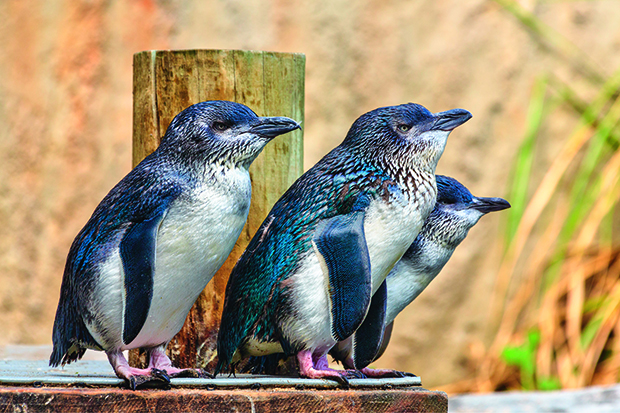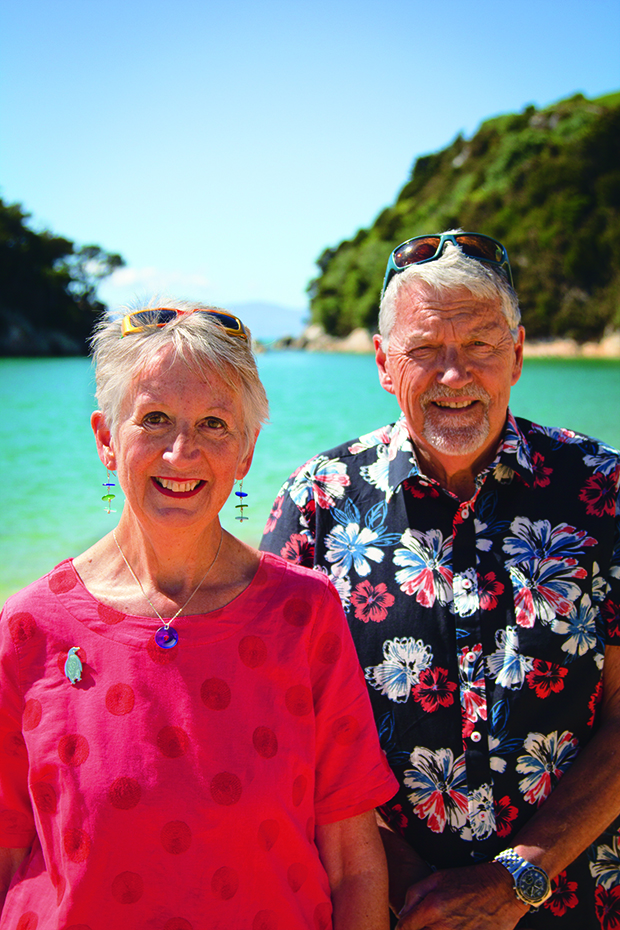The duo protecting kororā in Kaiteriteri

As little penguins make the risky journey to and from their burrows, a couple from Kaiteriteri, near the Abel Tasman National Park, act as their guardians, ensuring their safety along the way.
Words: Emily Beaumont
As darkness descends over the bays surrounding Kaiteriteri, little penguins (kororā) dutifully waddle up the same trails as their ancestors.
The routes are challenging. Humans encroach upon their traditional habitat, while dogs and cats threaten their lives. Former thriving colonies of little penguins (also known as little blue penguins) are now at risk.
Little Kaiteriteri Beach residents Linda Jenkins and Larry Lumsden are doing all in their power to make the nightly penguin treks as safe as possible.
The Canterbury couple, who fell in love with the penguins after moving to the beachside settlement five years ago, have become their staunch advocates and educators, dedicated to raising awareness among locals and visitors about the plight of the birds.
What began as the Love Our Little Blues group, responsible for creating information brochures and signage, evolved into the Tasman Bay Little Blue Penguin Trust in 2022.
The trust has initiated various projects, including beach clean-ups, installing warning signs and predator-trapping efforts against stoats and rats. Its cause has garnered volunteer support, including the Motueka Menzshed, which crafted and donated 60 penguin nest boxes.

Since settling in Kaiteriteri five years ago, Linda Jenkins and Larry Lumsden have been strong advocates for little penguins.
“That was practical and tangible support. We have already deployed 40 boxes and have 20 ready for anyone who discovers burrows on their properties and needs to offer more protection to their penguins.” Another 80 boxes, without flooring to enable the birds to burrow, have also been placed along the coastline.
Three years ago, a survey located 173 active burrows along the bays north and south of Kaiteriteri. The Kaikōura Ocean Research Institute conducted the study, and Linda and Larry hope to help fund further surveys to build a comprehensive data set.
Little penguins are so small, they are vulnerable to humans, human pets and predators — and cars, jet skis and boats.
“They’re so tiny and incredibly hard to spot, so the 30-kilometre road speed limit must be adhered to as a car strike is devastating.”
The trust’s honorary wildlife vet, Mana Stratton, has a purpose-built facility for injured birds. Penguin survivors of attacks and strikes, as well as orphaned chicks, are rehabilitated under her care.
The tragedy of a little penguin death is a stark reminder of the delicate balance that exists in shared ecosystems, say the couple who believe in collective responsibility, empathy and respect for the natural world.
“Even though they’re so little, they are extremely feisty, determined and loyal. We can’t help but admire their sheer grit and courage; despite everything we humans are throwing at them, they’re still making such an effort.”
LOVE OUR LITTLE PENGUINS – WHAT YOU CAN DO
● Join a trapping roster and clear predator traps.
● Keep dogs under 100 per cent control when in wildlife habitat areas. Be vigilant when penguins leave or return to the nest at dawn and dusk.
● Lock up cats at night.
● Keep to wet sand to avoid disrupting beach-nesting birds when beach walking.
● Volunteer to help with beach clean-ups.
● If you find an injured or dead penguin, call the DOC hotline, 0800 362 468.
FAST FACTS
● Little penguin/kororā — Eudyptula minor (the scientific name means “good little diver”)
● A protected native species, it is considered at risk and declining
● World’s smallest penguin
● Can swim up to 50 kilometres daily to feed chicks during the breeding season
● Swim speed: up to six kilometres an hour
● Dives to depths between five to 10 metres and to a maximum of 60 metres
● Eats small herring-sized fish, squid and krill
● Nests close to the sea in caves, rock crevices, under vegetation or tree roots, as well as nest boxes, under houses or wood piles
● Sleeps for about four minutes at a time
Love this story? Subscribe now!
 This article first appeared in NZ Life & Leisure Magazine.
This article first appeared in NZ Life & Leisure Magazine.
